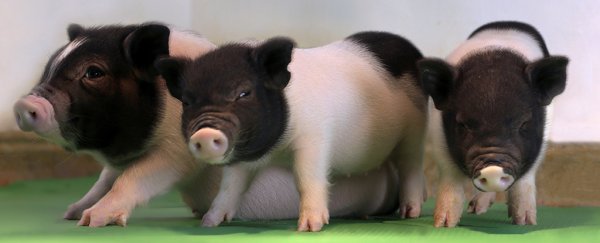Thanks to a life-science company's confirmed ability to create pigs completely free of a potentially infectious virus, we're closer than ever to delivering human transplant organs from pigs.
Fears that Porcine Endogenous Retrovirus (PERV) could leap from pigs to patients is one reason research has been slow when it comes to using pigs as a source of tissues for transplants. With each of the virus's 62 genetic copies successfully disabled in these young pigs, this risk becomes one less concern.
Several years ago, the US-based company eGenesis used the gene-editing technology CRISPR to inactivate the coding for a virus lurking inside the pig embryo's DNA.
Now they've announced their PERV-free embryos are healthy PERV-free piglets, the oldest being 4 months old.
Organ transplantation is a controversial topic at the best of times.
For those on waiting lists for a new liver or kidney, a family member can take on the risks and discomfort that comes with donating a part of their body.
In all other cases, it comes down to the uncomfortable hope that an accidental death under the right circumstances might provide compatible tissues.
The statistics and policies covering organ donation vary across different cultures, though in most nations supply still doesn't meet demand. Waiting lists are long and perfect donors are few, leaving many to die before their needs are met.
Under the best circumstances, recipients still face the risk of their body rejecting tissue that displays signs of being foreign.
Xenotransplantation is a procedure that aims to use animals to meet the need for healthy new organs.
Animals such as apes or pigs could be genetically engineered to produce tissues that don't advertise the fact they're foreign, providing not only a more generous supply of organs but a safer option as well.
CRISPR has proven a boon for engineering biology that is compatible with humans, playing a key role in the development of 'chimera' pig embryos last year that seemed on-track for growing human-like pancreases.
Cross-species virus transfer, however, has remained an important issue.
The PERV family aren't the only pathogen in town, but they are among the most concerning. As a retrovirus, PERV's genes are nestled inside the pig's DNA, and are similar to our own human endogenous retroviruses.
The difference is unlike our version of the virus, PERV can still pop out of its cosy spot and infect other cells.
So far the virus hasn't been shown to replicate inside our tissues, but both eGenesis's work and other laboratory tests have shown the pathogen still has the potential to be infectious.
Planting tissues that contain PERV right next to our own organs raises the risks of a dangerous new pathogen being formed, one which could potentially turn nasty.
In 2015, eGenesis announced they had used the revolutionary gene-editing technology CRISPR-Cas9 to target a record-breaking 62 genetic copies in a number of cloned pig embryos.
Cloning is still far from a perfect science, and many of those cell lines didn't make it very far.
But 15 of them did, and none show any sign of PERV in their cells.
"This is the first publication to report on PERV-free pig production," says Luhan Yang, chief scientific officer at eGenesis.
"This research represents an important advance in addressing safety concerns about cross-species viral transmission. Our team will further engineer the PERV-free pig strain to deliver safe and effective xenotransplantation."
Of course the thought of exploiting animals in such a way isn't everybody's cup of tea.
Society might have a broad acceptance of consuming them in the form of pork and bacon, but the idea of stitching pig tissues into our bodies is a whole other ball game.
As with many medical technologies, it is likely ethics and sentiments will evolve. That still leaves the practical challenges of making xenotransplantation a safer option.
We still have a long way to go before we see the first porcine kidneys giving a renal failure patient a new lease on life, but being able to cut out a risky virus could make it a reality sooner than we think.
This research was published in Science.
